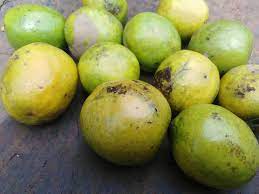Irvingia gabonensis,

|
|
Irvingia gabonensis Common Names: Bush mango, dika nut Local Names:
Ogbono (Igbo), Oro, Oyin (Yoruba), Ogwe, Ohere (Edo), Oro (Hausa) Scientific Classification Kingdom: Plantae Phylum: Tracheophyta Class: Magnoliopsida Order: Malpighiales Family: Irvingiaceae Genus: Irvingia Species: I. gabonensis Synonyms: Mangifera gabonensis Aubry-Lecomte ex
O'Rorke, Irvingia barteri Hook.f., Irvingia caerulea Tiegh., Irvingia
duparquetii Tiegh., Irvingia erecta Tiegh., Irvingia fusca Tiegh., Irvingia
griffonii Tiegh., Irvingia hookeriana Tiegh., Irvingia laeta Tiegh., Irvingia
pauciflora Tiegh., Irvingia platycarpa Tiegh., Irvingia tenuifolia Hook.f.,
Irvingia velutina Tiegh. Morphological Description Irvingia gabonensis,
commonly known as bush mango or African mango, is a large evergreen tree
reaching 15–40 m in height and 1–1.5 m in trunk diameter. Its key features
include: ·
Bark: Smooth to slightly scaly, grey to
yellowish-grey, exuding white latex when cut ·
Leaves: Alternate, elliptic to obovate, 5–10 cm
long, dark green, glossy above, with entire margins ·
Flowers: Small (3–5 mm), yellowish to
greenish-white, bisexual, in axillary or terminal panicles, blooming from March
to June ·
Fruit: Ellipsoidal drupes, 5–7 cm long, green
when unripe, yellow when ripe, with bright orange, juicy pulp and a single
woody seed, ripening from July to September Distribution and Habitat Irvingia gabonensis is
native to the humid forest zones of West and Central Africa, including Nigeria,
Cameroon, Gabon, Ghana, Democratic Republic of Congo, and Angola. It thrives
in: ·
Lowland
Tropical Forests: At elevations of
200–1,000 m, preferring well-drained, loamy soils with pH 4.5–6.5 ·
Primary
and Secondary Forests: Common
in both undisturbed and regenerating forests, often near rivers ·
Agroforestry
Systems: Planted in
mixed-crop farms for shade and fruit production, tolerating annual rainfall of
1,200–2,500 mm It is sensitive to
waterlogging and prolonged dry seasons, with optimal growth at 22–32°C (Ainge
& Brown, 2001). Ethnopharmacology Irvingia gabonensis is
extensively used in traditional medicine across West and Central Africa, with
ethnopharmacological studies validating several applications: Anti-obesity and Metabolic Health: Seed extracts (IGOB131, 150 mg twice daily) reduce body weight
(5.26% vs. 1.32% placebo, p<0.01), waist circumference, and triglycerides in
obese subjects, attributed to high fiber and modulation of PPAR-gamma and leptin
genes (Ngondi et al., 2009). Antidiabetic Activity: Aqueous leaf extracts inhibit α-amylase and α- glucosidase (IC₅₀ 21.42
μg/mL for ethanol extract), surpassing acarbose, supporting use for
diabetes management due to phytosterols like campesterol (Atanu et al., 2022). Antioxidant Properties: Ethanol leaf extracts show high DPPH scavenging (IC₅₀ 21.42 μg/mL) and
hydroxyl radical scavenging (81.43%), linked to phenolic (367.30 mg/100g GAE) and
flavonoid content, validating use for oxidative stress-related
conditions (Atanu et al., 2022). Antimicrobial Activity: Methanol stem bark extracts inhibit Staphylococcus aureus (MIC 2 mg/mL) and
Fusarium oxysporum, supporting use for scabies and skin infections
(Nguena et al., 2021). Analgesic and Anti-inflammatory: Stem bark extracts (100 mg/kg) reduce pain in mice by 60% in acetic
acid-induced writhing tests, validating use for toothache and
inflammation (Okolo et al., 1995). Hepatoprotective Effects: Ethanol leaf extracts reduce serum ALT, ALP, and GGT in arsenic-induced
hepatic stress in rats, supporting use for liver disorders (Gbadegesin, 2014). Phytochemical analyses
identify flavonoids, phenolic compounds, tannins, alkaloids, terpenoids
(e.g., betulinic acid), and phytosterols, contributing to its bioactivity. GC-MS
reveals fatty acids and glycosides, enhancing antimicrobial and antidiabetic effects
(Hassan et al., 2024). ⚠ Toxicity
Profile: Irvingia gabonensis seed
extracts are possibly safe at doses up to 1.05 g three times daily or 150 mg
of IGOB131 twice daily for 12 weeks, with minor side effects (flatulence,
headache, nausea). No acute toxicity is reported at doses up to 2,500 mg/kg in rats
(NOAEL). However, it may lower blood sugar or increase testosterone, posing
risks with diabetes medications or testosterone therapy. Avoid use before
surgery due to blood sugar effects, and consult a practitioner, especially during
pregnancy or breastfeeding (WebMD, 2016; Kothari et al., 2012). Additional Uses ·
Culinary: Seeds (ogbono) are ground into a viscous paste
for soups, valued for their high fat (50–60%) and protein (10–15%) content
(Ayuk et al., 1999). ·
Timber: The wood, with a density of 600–700 kg/m³, is used for
construction and furniture in local communities (Harris, 1996). ·
Economic: Kernels are traded internationally, with 140 tons valued at US$302,000
in Cameroon (1995), supporting livelihoods (Ayuk et al., 1999). ·
Industrial: Seed fat is used in soap and candle making, and the mucilage
serves as an emulsifier, outperforming acacia (Ainge & Brown, 2001). ·
Ecological: The tree provides shade in agroforestry systems and supports pollinators
(bees) and frugivorous birds, enhancing biodiversity (Ainge & Brown, 2001). References
External Links More Pictures |
|
| Compounds of Irvingia gabonensis, | |
| References | Murtala Muhammad, Etal. (2023). Phytochemical
analysis of Nigerian medicinal plants. NMPP-DB Project, Department of
Biochemistry, Kano University of Science and Technology, Wudil |